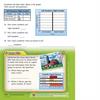Similar presentations:
Lesson Presentation Decimal Equivalents
1.
MathsFractions
Year One
Maths | Year 6 | Fractions | Decimal Equivalents | Lesson 1 of 3: Decimal Equivalents
2.
3.
Aim• I can calculate decimal fraction equivalents.
Success Criteria
4.
Fraction SpinnersSpin to generate fraction
Stand up
if it is greater than half.
Clap your hands
if it can be simplified.
4
12
5
Perform the actions relating to the
fraction created.
10
Click the button to spin the two
hexagons to generate a fraction at
the place where the edges meet.
5.
Fractions and DivisionFractions are another way of writing division.
4
7
Because of this, every fraction
has a decimal number equivalent
which we calculate by doing the
division.
6.
Fractions and DivisionSome decimal number equivalents we can learn as facts:
1
2
0.5
1
10
0.1
1
4
0.25
3
4
0.75
7.
Fractions and DivisionHowever, some decimal number equivalents need to be calculated:
7
8
?
5
6
?
2
7
?
1
9
?
8.
Calculating a Decimal EquivalentWhen we want to calculate a decimal equivalent of a fraction, we use the written
method of short division:
0 8 7 5
8 7 0 60 40
We add the decimal
point and the zeros
to the calculation
because we know
the answer will be a
decimal number less
than one.
Step 1: Calculate 70 ÷ 8
The multiple of 8 that comes immediately before 70 is
64, 64 = 8 8, so 70 8 = 8 remainder 6
Step 2: Calculate 60 ÷ 8
The multiple of 8 that comes immediately before 60 is
56, 56 = 7 8, so 60 8 = 7 remainder 4
Step 3: Calculate 40 ÷ 8 40 is a multiple of 8, 40 = 5
8, so 40
8=5
9.
Calculating a Decimal EquivalentHave a go at using the written method of short
division to find the decimal equivalent of this fraction:
0 2 8 65 7
7 2 0 60 40 50
This decimal equivalent
has a very long string of
decimal numbers. When
this happens, we want to
round the decimal
number to the nearest
thousandth.
To do this, we need to
calculate the value of the
next digit.
Step 1: Calculate 20 ÷ 7
The multiple of 7 that comes immediately before 20 is
14, 14 = 2 7, so 20 7 = 2 remainder 6
Step 2: Calculate 60 ÷ 7
The multiple of 7 that comes immediately before 60
is 56, 56 = 8 7, so 56 7 = 8 remainder 4
Step 3: Calculate 40 ÷ 7
The multiple of 7 that comes immediately before 40 is
35, 35 = 5 7, so 35 7 = 5 remainder 5
Step 3: Calculate 50 ÷ 7
The multiple of 7 that comes immediately before 50 is 49,
49 = 7 7, so the next digit after the thousandths is a 7.
10.
Calculating a Decimal EquivalentWhen we want to calculate a decimal equivalent of a fraction, we use the written
This decimal equivalent
method of short division:
is recurring. This means
that the same digit will
repeat for infinity! To
show this, we place a dot
2 2
over the recurring digit.
0 8 3 3
6 5 0 0 0
Step 1: Calculate 50 ÷ 6
The multiple of 6 that comes immediately before 50 is
48, 48 = 8 6, so 50 6 = 8 remainder 2
Step 2: Calculate 20 ÷ 6
The multiple of 6 that comes immediately before 20 is
18, 18 = 3 6, so 20 6 = 3 remainder 2
Step 3: Calculate 20 ÷ 6
The multiple of 6 that comes immediately before 20 is
18, 18 = 3 6, so 20 6 = 3 remainder 2
11.
Decimal Equivalents12.
Diving into MasteryDive in by completing your own activity!
13.
Tarsia Domino PuzzleMatch the edges of the triangles and squares together by calculating the
decimal fraction equivalents.
14.
Aim• I can calculate decimal fraction equivalents.
Success Criteria















 english
english








